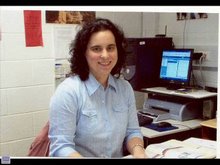 We’ve left Pamukkale and are heading towards Konya, home of the Sufi mystic and poet Romi who founded the Mevlevi Order of the Whirling Dervishes. The journey today is long ( 6 hours), but it has given me time to get caught up on my journaling. The view out my
We’ve left Pamukkale and are heading towards Konya, home of the Sufi mystic and poet Romi who founded the Mevlevi Order of the Whirling Dervishes. The journey today is long ( 6 hours), but it has given me time to get caught up on my journaling. The view out my  window continues to be mountainous and dry. This road we are taking follows the old southern route of the Silk Road.
window continues to be mountainous and dry. This road we are taking follows the old southern route of the Silk Road.Late in the day we arrived to Konya. Konya’s history goes back 4,000 years ago to when the Hitites called this city “Kuwanna.” The Romans called this city Iconium and the Turks called it Konya. Iconium was an important Roman provincial town and visited several times by St. Paul and St. Barnabas. Under the Turks, Konya was the capital of the Seljuk Sultanate of Rum.
Finally after a long day’s bus journey we arrived in Konya and spend some time at the Mevlana Museum. This museum is filled with pilgrims and visitors who to pay respect to
 Turkey’s greatest saint, Mevlana Rumi, mystic, poet and religious writer.
Turkey’s greatest saint, Mevlana Rumi, mystic, poet and religious writer.Rumi was born in 1207 in Balkh, Afghanistan and fled as a young boy the invading Mongols by moving first to Mecca and later to Rum, reaching Konya in 1228. His father being a noted Sufi preacher, Rumi became a brilliant student of Islamic theology. He
 studied in Aleppo and Damascus after his father’s death and later accepted an offer to return to Konya in 1240. It was in Konya that he met his very close friend Mehmet Tebrizi, one of his father’s Sufi mystics. Together they spent much time together discussing philosophical topics. Mevlana abandoned his teachings and rarely appeared in public. Tebrizi had a profound influence on Rumi. His disciples became jealous, believing their master had been bewitched by an evil sorcerer. They plotted to have Tebrizi killed in 1247. Heartbroken by this loss, Tebrizi withdrew from the world to meditate and write his great poetic work, Mesnevi.
studied in Aleppo and Damascus after his father’s death and later accepted an offer to return to Konya in 1240. It was in Konya that he met his very close friend Mehmet Tebrizi, one of his father’s Sufi mystics. Together they spent much time together discussing philosophical topics. Mevlana abandoned his teachings and rarely appeared in public. Tebrizi had a profound influence on Rumi. His disciples became jealous, believing their master had been bewitched by an evil sorcerer. They plotted to have Tebrizi killed in 1247. Heartbroken by this loss, Tebrizi withdrew from the world to meditate and write his great poetic work, Mesnevi.His teachings can be summarized with this verse:
Come, whoever you may be,
Even if you may be,
An infidel, a pagan, or a fire-worshipper,
come.
Ours is not a brotherhood of despair.
Even you have broken
Your vows of repentance a hundred
times, come.
Rumi died December 13, in 1273 and his death was described by him as his “wedding day” with Allah. After his death, his son continued on his following by forming a brotherhood called the Mevlevi, or Whirling Dervishers.
Today, the site of his tomb is considered to be a very holy place visited by 1.5 million pilgrims a year.



















































